湘教版四年级上册英语教案
- 格式:doc
- 大小:368.31 KB
- 文档页数:81

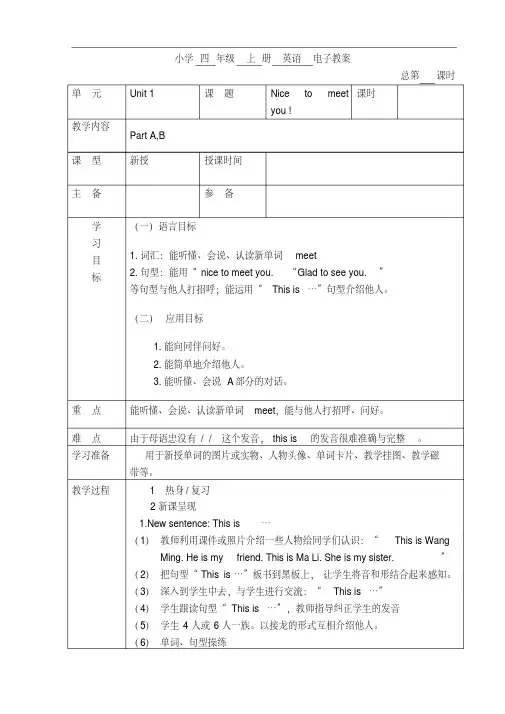
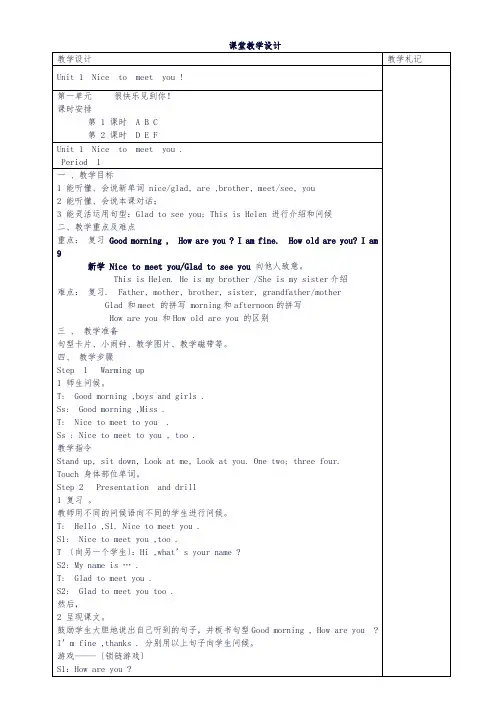
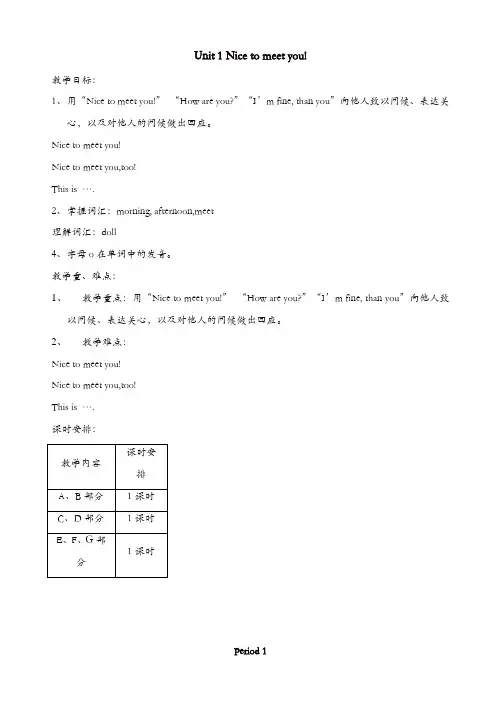
Unit 1 Nice to meet you!教学目标:1、用“Nice to meet you!”“How are you?”“I’m fine, than you”向他人致以问候、表达关心,以及对他人的问候做出回应。
Nice to meet you!Nice to meet you,too!This is ….2、掌握词汇:morning, afternoon,meet理解词汇:doll4、字母o在单词中的发音。
教学重、难点:1、教学重点:用“Nice to meet you!”“How are you?”“I’m fine, than you”向他人致以问候、表达关心,以及对他人的问候做出回应。
2、教学难点:Nice to meet you!Nice to meet you,too!This is ….课时安排:Period 1一、教学目标1、能听懂、会说新单词morning;2、能听懂、会说本课对话;3、能灵活运用“Nice to meet you!”“How are you?”等问候语进行日常问候。
二、教学重点及难点重点:用“Nice to meet you!”“How are you?”向他人致意。
难点:This is ….三、教学准备句型卡片、小闹钟、教学挂图、教学磁带等。
四、教学步骤Step 1 Warming up1、师生问候。
T Good morning, boys and girls.S Good morning, Miss eng.2、游戏——击鼓传球击鼓传球,鼓声停时,球落在谁的手里,则需迅速地用一个单词描叙他的暑假生活,如happy, good等。
Step 2 Presentation and drill1、复习。
老师用不同的问候语向不同的学生进行问候。
T Hello, S1. Nice to meet you.S1 Nice to meet you ,too.T(向另一个学生)Hi, what’s your name?S2 My name is S2.T Glad to meet you. http//ww w.b1S Glad to meet you too.然后,老师把闹钟分别拨到不同的时间(上午九点、下午三点、晚上八点)。
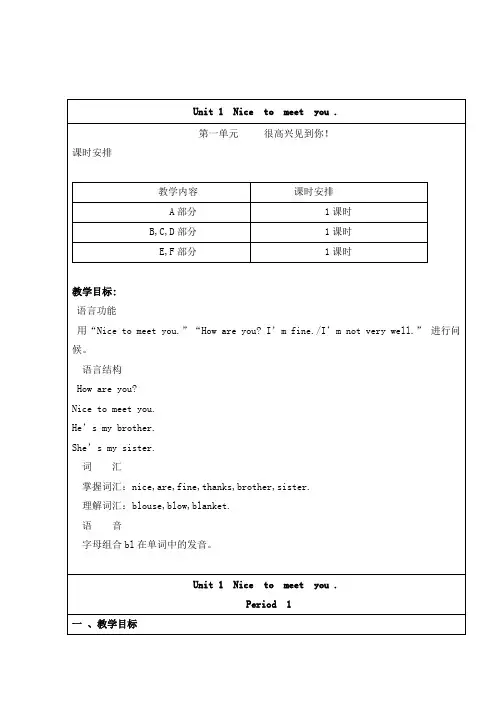
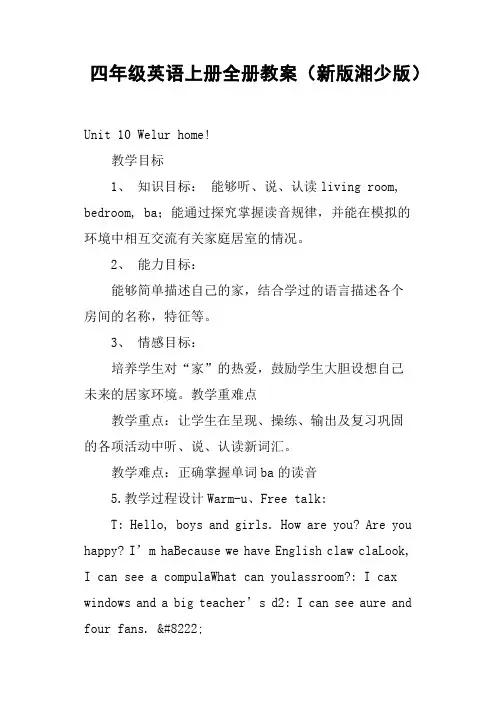
四年级英语上册全册教案(新版湘少版)Unit 10 Welur home!教学目标1、知识目标:能够听、说、认读living room, bedroom, ba;能通过探究掌握读音规律,并能在模拟的环境中相互交流有关家庭居室的情况。
2、能力目标:能够简单描述自己的家,结合学过的语言描述各个房间的名称,特征等。
3、情感目标:培养学生对“家”的热爱,鼓励学生大胆设想自己未来的居家环境。
教学重难点教学重点:让学生在呈现、操练、输出及复习巩固的各项活动中听、说、认读新词汇。
教学难点:正确掌握单词ba的读音5.教学过程设计Warm-u、Free talk:T: Hello, boys and girls. How are you? Are you happy? I’m haBecause we have English claw claLook, I can see a compulaWhat can youlassroom?: I cax windows and a big teacher’s d2: I can see aure and four fans. „T: Yeah, our clabig 、clean and beautiful.【设计意图】给学生提供滚动运用旧语言的机会,激活学生已有的与本课相关的旧知识,旧技能,并为引出新课做铺垫。
2. Sing a song: In the cla(学生边拍手边唱)【设计意图】轻松愉快的歌曲既可活跃课堂气氛,有可过渡到本课话题。
2. PresentaT: Look alook carefully. What’s this? W?(课件呈现一把椅子):It’s a chair. It’s near the desk. 接着出示书包,请学生猜测是什么,在哪里。
T:(出示书本)What’s this?: It’s a bT: Can you guess w? 学生猜测书本的具体位置。
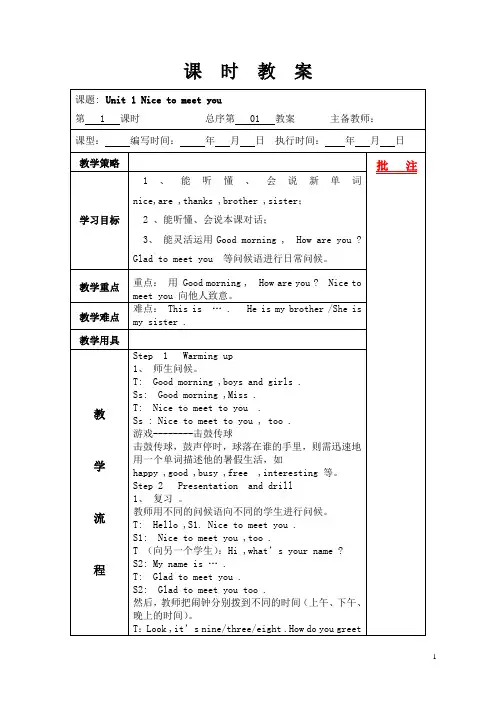
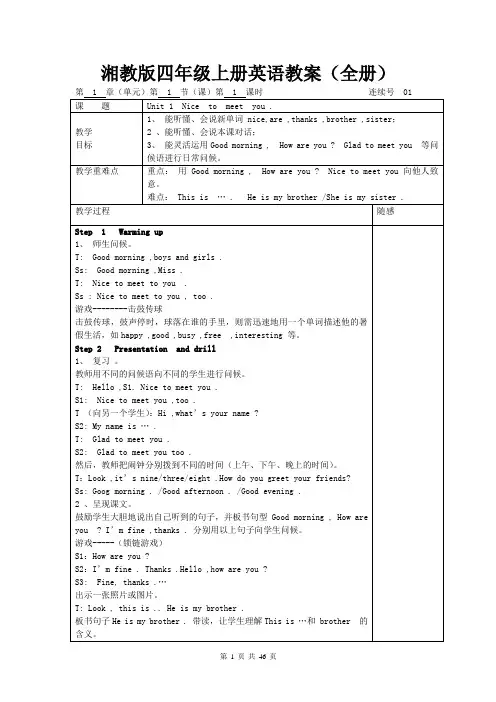
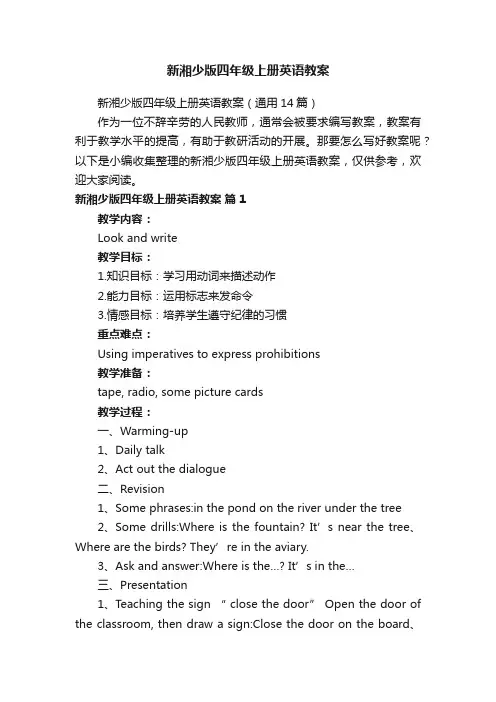
新湘少版四年级上册英语教案新湘少版四年级上册英语教案(通用14篇)作为一位不辞辛劳的人民教师,通常会被要求编写教案,教案有利于教学水平的提高,有助于教研活动的开展。
那要怎么写好教案呢?以下是小编收集整理的新湘少版四年级上册英语教案,仅供参考,欢迎大家阅读。
新湘少版四年级上册英语教案篇1教学内容:Look and write教学目标:1.知识目标:学习用动词来描述动作2.能力目标:运用标志来发命令3.情感目标:培养学生遵守纪律的习惯重点难点:Using imperatives to express prohibitions教学准备:tape, radio, some picture cards教学过程:一、Warming-up1、Daily talk2、Act out the dialogue二、Revision1、Some phrases:in the pond on the river under the tree2、Some drills:Where is the fountain? It’s near the tree、Where are the birds? They’re in the aviary.3、Ask and answer:Where is the…? It’s in the…三、Presentation1、Teaching the sign “ close the door” Open the door of the classroom, then draw a sign:Close the door on the board、Say and write:Close the door、Prompt an individual student to close the door、Introduce:a sign Show some signs to the students2、Draw other signs in Look and read on one side of the board、Don’t feed the birds、Don’t pick the flowers、Do n’t climb the trees、Don’t walk on the grass、Don’t play in the pond.Read these signsLook and sayGuessing game3、Draw a park scene on the board, then practice the signsTalk about the parkAsk students to copy the signs you have drawn on the board and put them in the right places in the park.Encourage the students to include other signs that they might find in the park.四、Consolidation1、Listen and repeat2、Have the students work in pairs to write the numbers of the signs in the appropriate red circles.3、Distribute a copy of photocopiable page 36 to each student.Find the correct signs.新湘少版四年级上册英语教案篇2教学内容:Look and read Play a game教学目标:1.知识目标:Using possessive adjectives to show possession Using nouns phrases to identify people,animals,events,objects and activities Asking simple questions to obtain yes/no answers2.能力目标:Communicate with teachers or other learners3.情态目标:爱护绿化重点难点:Its stalk is long、Has it got …?Teaching aids:pictures,recorder教学过程:一、Warming –up1,Sing a song2,Daily talkRevision Review:stalk,leaves,flowers,roots,二、Presentation1.Show a picture of a plant with flowers、Ask:What is it?Is ita tree? To elicit:a plant/ Ask:What colour are the flowers? What colour are the leaves? To elicit:They?re… Ask:Are they long or short? To elicit:They?re long(short) .2.Draw another plants、Say:Look at this plant.Its flowers are red、Look at that plant .Its flowers are purple.3.Listen to the tape.4.Say sth.about the plant .Show a picture of a tree、Introduce:a trunk,branches.Make sentences:Its trunk is big、It branches are long.Listeen to the tape.Say sth about the tree.Play the cassette:Play a game/ Listen and repeat.Play this game.三、Consolidation1.Photocopiable pages 44-45.2.Workbook page 29.3.Grammar practice book 4a page 35.板书设计:Unit 2 Look at, Its stalk is…Its trunk is…leaves are …branches… roots flowers新湘少版四年级上册英语教案篇3教学目标:1.能听懂、会说、会读交际用语:Welcome to … What are these/those?They’re …Are these/those …? Yes, they are./No, they aren’t2.能听懂、会说、会读词汇:they’re=they are, pig, cow, chicken, duck3.能听懂、会说、会读、会写词汇:farm, they, pig, apple, those4.能熟练朗读对话或表演对话。
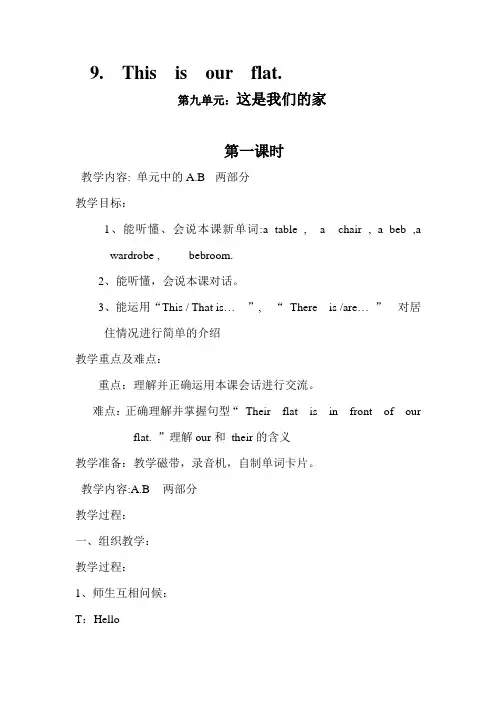
9. This is our flat.第九单元:这是我们的家第一课时教学内容: 单元中的A.B 两部分教学目标:1、能听懂、会说本课新单词:a table , a chair , a beb ,awardrobe , bebroom.2、能听懂,会说本课对话。
3、能运用“This / That is…”, “There is /are…”对居住情况进行简单的介绍教学重点及难点:重点:理解并正确运用本课会话进行交流。
难点:正确理解并掌握句型“Their flat is in front of our flat. ”理解our和their的含义教学准备:教学磁带,录音机,自制单词卡片。
教学内容:A.B 两部分教学过程:一、组织教学:教学过程:1、师生互相问候:T:HelloS:Hello.2、唱一首英文歌曲:I can sing my ABC二. A部分的教学。
(Let’s listen and say)学习主句:This is our flat.Their flat is in front of our flat.听录音朗读A部分。
1,指导学生看图,分析A部分的句子,然后听录音朗读A部分的句子,(1)跟读句子.Thi is our flat. Aanne, Our flat is number 9.That is their flat, their flat is number 10.Their flat is in ftont of our flat.Our door is blue. Their door is brown.(2),情景对话,根据A部分的内容进行对话练习.2、句型练习:Thi is …That is their ………3、指导学生朗读。
三、B部分的教学。
(Let’s learn)单词教学1.出示单词卡片。
a table , a chair , a bed , a wardrobe , a bedroom.一张桌子一把椅子一张床一个衣柜一间卧室一个卧室A:听录音朗读。
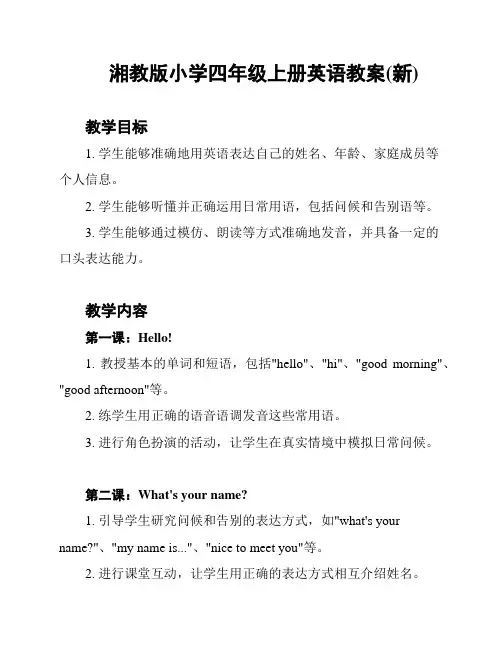
湘教版小学四年级上册英语教案(新)教学目标1. 学生能够准确地用英语表达自己的姓名、年龄、家庭成员等个人信息。
2. 学生能够听懂并正确运用日常用语,包括问候和告别语等。
3. 学生能够通过模仿、朗读等方式准确地发音,并具备一定的口头表达能力。
教学内容第一课:Hello!1. 教授基本的单词和短语,包括"hello"、"hi"、"good morning"、"good afternoon"等。
2. 练学生用正确的语音语调发音这些常用语。
3. 进行角色扮演的活动,让学生在真实情境中模拟日常问候。
第二课:What's your name?1. 引导学生研究问候和告别的表达方式,如"what's your name?"、"my name is..."、"nice to meet you"等。
2. 进行课堂互动,让学生用正确的表达方式相互介绍姓名。
3. 进行多次朗读与模仿,培养学生准确的语音和语调。
第三课:How old are you?1. 教授数字1-10的英文表达,如"one"、"two"、"three"等。
2. 引导学生研究问候和回答关于年龄的问题,如"How old are you?"、"I'm..."等。
3. 制作数学计数游戏的卡片,让学生通过游戏的方式进行数字的记忆和运用。
第四课:Family1. 引导学生研究用英语表达家庭成员,如"father"、"mother"、"brother"等。
2. 进行图片展示和课堂讨论,让学生用英语描述自己的家庭成员。
3. 进行小组活动,让学生模拟家庭对话,展示自己学到的表达方式。
湘教版小学四年级上册英语教案课时一:Greeting- 教学目标:- 研究日常问候用语:Hello, Hi, Good morning, Good afternoon - 研究回答问候用语:Hello, Hi, Good morning, Good afternoon - 能够利用所学问候用语和同伴进行简单的交流- 教学重点:- 日常问候用语的研究和掌握- 听、说、读、写能力的培养- 教学准备:- 教师准备:黑板、单词卡片- 教学过程:1. Warming Up- 利用图片引入问候用语的主题,激发学生的研究兴趣。
2. Presentation- 出示问候用语的图片或单词卡片,教师读出并让学生跟读,帮助学生熟悉发音和意义。
- 教师解释每个问候用语的使用场景,引导学生理解其含义。
3. Practice- 教师带领学生进行角色扮演,模拟日常问候情景,让学生运用所学问候用语进行交流。
- 学生两两搭档,互相问候并回答,教师巡视并给予指导和帮助。
4. Production- 学生利用所学问候用语,和其他学生进行问候和简单交流,展示所学的能力。
- 教师进行点评和表扬,鼓励学生积极参与。
课时二:Numbers- 教学目标:- 研究英语数字1-20的读法和写法- 掌握数字1-20的顺序和基本应用场景- 能够进行简单的计数和问答练- 教学重点:- 数字1-20的读写能力的培养- 听、说、读、写能力的综合发展- 教学准备:- 教师准备:黑板、数字卡片、课件- 教学过程:1. Warming Up- 利用数字图片或卡片引入数字的主题,激发学生的研究兴趣。
2. Presentation- 出示数字卡片,教师读出并让学生跟读,帮助学生熟悉发音和形状。
- 通过课件展示数字的形象和书写,引导学生正确书写并加深对数字的认识。
3. Practice- 教师和学生一起进行数字计数,学生跟读并模仿发音。
- 学生进行数字的问答练,教师提问并指导学生回答。
小学四年级上册英语电子教案总第课时单元Unit 1 课题Nice to meetyou !课时教学内容Part A,B课型新授授课时间主备曾娟参备学习目标(一)语言目标1.词汇:能听懂、会说、认读新单词meet2.句型:能用“nice to meet you.“Glad to see you.”等句型与他人打招呼;能运用“This is…”句型介绍他人。
(二)应用目标1.能向同伴问好。
2.能简单地介绍他人。
3.能听懂、会说A部分的对话。
重点能听懂、会说、认读新单词meet,能与他人打招呼、问好。
难点由于母语忠没有/ /这个发音,this is的发音很难准确与完整。
学习准备用于新授单词的图片或实物、人物头像、单词卡片、教学挂图、教学磁带等。
教学过程 1 热身/复习2新课呈现1.New sentence: This is …(1)教师利用课件或照片介绍一些人物给同学们认识:“This is Wang Ming. He is my friend. This is Ma Li. She is my sister.”(2)把句型“This is…”板书到黑板上,让学生将音和形结合起来感知。
(3)深入到学生中去,与学生进行交流:“This is…”(4)学生跟读句型“This is…”,教师指导纠正学生的发音(5)学生4人或6人一族。
以接龙的形式互相介绍他人。
(6)单词、句型操练①利用磁带的地道发音带读。
②情景操练:给学生带上熟悉的人物面具或头饰,运用句型:“This is…”进行表演。
2.The dialogue课文学习:教师可分步骤循序渐进地引导学生熟悉课文。
第一步:初步了解课文(1)Listen and find the people.不打开书,只听音,听音前,给出任务:你听到了那些人物的名称?(2)Listen and tell what you hear.再次听音,复述你所听到的句子第二步:熟悉课文(1)Listen and rearrange the sentences.听音,将黑板上的句子按顺序排列。
最新湘教版四年级上册英语教案(全册)Unit 1: Greetings and IntroductionsLesson 1: Greetings- Objective: To learn basic greetings in English- Teaching Materials: Greeting cards, flashcards, audio recording- Teaching Procedure:- Review previous knowledge on greetings in Chinese- Introduce English greetings through flashcards and audio recording- Practice greetings through role-play activities using greeting cards - Consolidate learning through a class discussion on the importance of greetings in different cultures- Assessment: Observe and provide feedback during role-play activitiesLesson 2: Introductions- Objective: To introduce oneself and others in English- Teaching Materials: Flashcards, name tags, audio recording- Teaching Procedure:- Review English greetings from the previous lesson- Introduce vocabulary for self-introduction using flashcards and audio recording- Model and practice self-introductions in pairs using name tags- Extend the activity to introduce others in the class- Assessment: Observe and assess students' ability to introduce themselves and others accuratelyUnit 2: Numbers and ColorsLesson 1: Numbers 1-10- Objective: To learn numbers 1-10 in English- Teaching Materials: Flashcards, number charts, audio recording - Teaching Procedure:- Review previous knowledge on counting in Chinese- Introduce numbers 1-10 through flashcards, audio recording, and number charts- Practice counting and recognizing numbers through various classroom activities- Assessment: Observe and assess students' ability to count and recognize numbers accuratelyLesson 2: Colors- Objective: To learn basic colors in English- Teaching Materials: Flashcards, color swatches, audio recording - Teaching Procedure:- Review English numbers 1-10 from the previous lesson- Introduce vocabulary for colors using flashcards, audio recording, and color swatches- Practice identifying colors through games and creative activities - Assessment: Observe and assess students' ability to identify colors accuratelyUnit 3: Family and FriendsLesson 1: Family Members- Objective: To learn vocabulary for family members in English- Teaching Materials: Flashcards, family tree visuals, audio recording- Teaching Procedure:- Review previous knowledge on family relationships in Chinese- Introduce vocabulary for family members through flashcards, audio recording, and family tree visuals- Practice using family vocabulary through speaking and writing activities- Assessment: Observe and assess students' ability to use family vocabulary accuratelyLesson 2: Friends- Objective: To talk about friends in English- Teaching Materials: Picture cards, audio recording- Teaching Procedure:- Introduce vocabulary for different types of friends using picture cards and audio recording- Practice describing friends' characteristics and expressing preferences through group discussions- Assessment: Observe and assess students' ability to describe friends accurately and express preferencesUnit 4: Daily RoutinesLesson 1: Daily Activities- Objective: To learn vocabulary for daily activities in English- Teaching Materials: Flashcards, daily routine visuals, audio recording- Teaching Procedure:- Introduce vocabulary for daily activities through flashcards, audio recording, and daily routine visuals- Practice talking about daily activities through role-play and writing activities- Assessment: Observe and assess students' ability to talk about daily activities accuratelyLesson 2: Time and Daily Routine- Objective: To tell time and describe daily routines in English- Teaching Materials: Clock visuals, daily routine visuals, audio recording- Teaching Procedure:- Review English numbers from previous lessons- Introduce vocabulary for time and daily routines through clock visuals, daily routine visuals, and audio recording- Practice telling time and describing daily routines through various activities- Assessment: Observe and assess students' ability to tell time and describe daily routines accurately总结:本教案分为四个单元,每个单元包含两个课时。
四年级新湘少版英语上册教案全册一、第一单元:Hello, Classmates!1. 教学目标1.1 知识目标1.1.2.1 Hello, my name is1.1.2.2 Nice to meet you.1.1.2.3 What's your name?1.1.2.4 How old are you?1.1.2.5 I'm twelve.1.1.2.6 I'm in Class 4, Grade 4.1.1.2.7 What class are you in?1.1.2.8 What subjects do you like?1.1.2.9 I like math.1.1.2.10 I have a pen, a pencil, and an eraser.1.2 能力目标1.2.1 能够用英语进行简单的自我介绍和询问他人信息。
1.2.2 能够用英语介绍自己的学习用品。
1.3 情感目标1.3.1 培养学生的学习兴趣和积极性。
1.3.2 培养学生热爱学校和尊敬老师的情感。
2. 教学重点与难点2.1 重点:单词classmate, teacher, student, school, subject, pen, pencil,eraser, book, bag, puter的认读和运用。
2.2 难点:句子结构的掌握和运用。
3. 教学步骤3.1 Step 1: 热身活动(5分钟)3.1.2 学生模仿教师进行自我介绍。
3.2 Step 2: 引入新课(10分钟)3.2.1 教师展示图片,引导学生说出对应的单词,如:classmate, teacher, student, school, etc.3.2.2 学生跟读单词。
3.3 Step 3: 学习句子(10分钟)3.3.1 教师播放录音,学生听并模仿句子。
3.3.2 学生两人一组进行角色扮演,练习句子。
3.4 Step 4: 实践活动(10分钟)3.4.1 教师组织学生进行小组活动,用所学单词和句子进行交流。
新湘少版四年级上册英语教案教案标题:新湘少版四年级上册英语教案教案目标:1. 帮助学生熟练掌握四年级上册英语中的词汇、句型和常用表达方式。
2. 培养学生的英语听、说、读、写的基本能力。
3. 培养学生的学习兴趣和自主学习能力。
4. 加强学生的互动交流能力。
教学内容:Unit 1 My SchoolUnit 2 My SchoolbagUnit 3 My ClassroomUnit 4 This is My FriendUnit 5 Happy BirthdayUnit 6 What's in Your Bag?Unit 7 My FamilyUnit 8 My Body教学重点:1. 学习并掌握每个单元的词汇和句型。
2. 培养学生的听力和口语能力。
3. 引导学生在日常生活中运用所学英语进行简单的交际。
教学难点:1. 教学新词汇和短语。
2. 引导学生进行口语交际,培养他们的口语表达能力。
教学方法:1. 情景教学法:通过日常生活场景的情景教学,激发学生学习英语的兴趣,增强记忆效果。
2. 师生互动法:通过师生互动,学生与学生之间的互动,激发学生的学习积极性和主动性。
教学过程:Step 1:Warm-up(热身)通过唱英语歌曲、英语问候等方式,激发学生的学习兴趣,创设英语氛围。
Step 2:Presentation(呈现)1. 导入新词汇和短语,通过图片、实物等方式呈现,激发学生的学习兴趣。
2. 引导学生模仿老师的发音和表达,帮助他们正确掌握发音和语调。
Step 3:Practice(练习)1. 师生问答:老师通过问答的方式,引导学生使用所学的词汇和句型进行回答。
2. 情景对话:学生通过情景对话的方式,练习使用所学的语言进行交际。
Step 4:Consolidation(巩固)通过小组活动、角色扮演等方式,让学生巩固所学内容。
Step 5:Extension(拓展)通过游戏、听写等方式,帮助学生巩固语言知识,拓展学习内容。
Unit 1 Nice to meet you教学目标:1、用“Good morning!”“How are you?”“I’m fine, thank you”向他人致以问候、表达关心,以及对他人的问候做出回应。
2、Is he your brother?Yes, he is.This is Helen.3、掌握词汇:morning, afternoon理解词汇:blouse, blade, block, blow, blanket, blue, balloon, black, bow, friendly 4、字母组合bl在单词中的发音。
教学重、难点:1、教学重点:用“Good morning!”“How are you?”“I’m fine, thank you”向他人致以问候、表达关心,以及对他人的问候做出回应。
2、教学难点:Is he your brother?Yes, he is.This is Helen.课时安排:Period 1一、教学目标1、能听懂、会说新单词morning;2、能听懂、会说本课对话;3、能灵活运用“Good morning!”“How are you?”等问候语进行日常问候。
二、教学重点及难点重点:用“Good morning!”“How are you?”向他人致意。
难点:Is he your brother?三、教学准备句型卡片、小闹钟、教学挂图、教学磁带等。
四、教学步骤Step 1 Warming up1、师生问候。
T: Good morning, boys and girls.S: Good morning, Miss.T: Nice to see you again.S: Nice to see you again too.游戏——击鼓传球击鼓传球,鼓声停时,球落在谁的手里,则需迅速地用一个单词描叙他的暑假生活,如happy, good等。
Step 2 Presentation and drill1、复习。
老师用不同的问候语向不同的学生进行问候。
T: Hello, S1. Nice to meet you.S1: Nice to meet you too.T(向另一个学生): Hi, what’s your name?S2: My name is S2.T: Glad to meet you.S: Glad to meet you too.然后,老师把闹钟分别拨到不同的时间(上午九点、下午三点、晚上八点)。
T:Look! It’s nine/three/eight. How do you greet your friends?S: Good morning. /Good afternoon./ Good evening.2、呈现课文。
T:Now, listen to the tape please. What are they saying?鼓励学生大胆地说出自己听到的句子,并板书句型“Good morning.”“How are you?”“I’m fine, thank you.”分别用以上句子向学生问候。
游戏——Chain game(锁链游戏)S:How are you?S1: Fine, thank you.Hello, how are you?S2: Fine, thanks.……(可分组游戏,看哪组说得又快又好)出示一张照片(或图片)。
T: Look, this is …He is my brother.板书句子“He is my brother.”,带读,让学生理解“This is…”和brother的含义。
走到一学生面前。
T: Hello, how are you?S: Fine, thanks.T(指着旁边一个男生问):Is he your brother?S: No, he isn’t.3、听课文A部分,跟读。
4、三人(每组至少有一名男学生)小组练习。
Step 3 Practice操练和运用课文B部分。
1、问学生们想不想念他们的老朋友Dino,请他们运用今天学习的句型向Dino问好。
(Dino可由学生或教师扮演)2、结合以上表演向Dino介绍你的新同学。
3、听课文B部分录音,分角色表演。
Step 4 Consolidation1、创设情景,自由会话。
情景:你和妈妈在超市碰到了同学。
你和同学在公园里遇到了邻居。
你和爸爸在书店碰到了老师。
(可先请基础好的同学示范)2、评价。
3、练习。
4、家庭作业:听磁带、背课文。
Period 2一、教学目标1、能听懂、会说课文C部分对话;2、能用“This is…”介绍朋友;3、能阅读并理解课文D部分小故事。
二、教学重点及难点重点:创设情景练习用“This is…”介绍他人。
难点:This is Helen. Who are you?三、教学准备教学挂图、教学磁带等。
四、教学步骤Step 1 Warming up1、师生问候。
T: Good morning, boys and girls. How are you?S: I’m fine, thank you.可适当增加几种回答的方法,如“Just so so.”“I’m sick today.”等。
2、老师运用课文A、B部分的语言向单个学生问候。
Step 2 Presentation and drill1、老师叫两名学生上台。
T:Hello, how are you?S1: Fine, thank you.S2: Fine, thank you.T(指着其中一个学生问):This is S1, and this is S2.鼓励学生互相问候。
S1: Glad to meet you.S2: Nice to meet you.2、板书句子“This is…”,并告诉学生这个句型可用来介绍朋友。
Step 3 Practice1、阅读对话。
2、学生三人一组表演对话。
Step 4 Consolidation1、创设情景,自由会话。
情景A:老师来你家家访,你先向老师问好,然后,你介绍老师和父母相互认识。
情景B:在你的生日聚会上,介绍不相识的朋友认识。
2、课文D部分。
1)带着问题阅读课文D部分小故事。
T:What can you see in the picture?How does Dino greet the dog?What is Dino saying?How does the dog greet Dino?What is the dog saying?2)听课文D部分录音,跟读。
3)三人一组表演对话。
3、评价。
对学生的表演进行评价,评出“礼貌奖”。
4、练习。
5、家庭作业。
听磁带,读故事。
Period 3一、教学目标1、能掌握字母组合bl在单词中的发音,能理解新单词;2、会读由含有字母组合bl的单词组成的句子;3、能掌握单词morning, afternoon的书写句子;4、能唱英语歌曲“Good morning to you.”。
二、教学重点及难点重点:字母组合bl在单词中的发音;英语歌曲“Good morning to you.”难点:理解新单词,熟读句子。
三、教学准备四线三格小黑板、单词卡片、教学磁带等。
四、教学步骤Step 1 Warming up1、师生问候。
2、复习已学的问候语。
游戏——A little actor(小演员)在若干张小纸条上写上时间、地点及人名,学生任意抽取,然后按纸条上的内容围绕本单元的功能项目自由设计情景,进行表演。
评出“最佳演员”。
可分组进行游戏。
Step 2 Presentation and drill1、出示一些已学过的含有字母组合bl的单词,让学生自己寻找其发音规律。
2、出示课文E部分新单词卡片。
让基础较好的学生读出新单词,其他学生仔细听。
3、听课文E部分字母组合、单词和句子,跟读。
理解句子意思。
4、可分组进行“绕口令”比赛。
5、示范单词morning, afternoon的书写,让学生们边读单词边书空。
然后让学生按照范例练习书写,评出“小小书法家”。
Step 3 Practice游戏——A little master-hand(小小能手)老师给出blouse, blade, blanket, blue, block等单词卡片,提示元音部分的发音,学生读出单词,看谁读得最快最准,评出“拼读小能手”。
Step 4 Consolidation1、学唱课文F部分英语歌曲“Good morning to you.”。
1)播放录音,让学生们说说听到的内容。
2)听录音,跟唱,并做动作。
3)分组进行唱歌表演比赛。
2、评价。
对学生的表演唱进行评价,给予鼓励和奖励,激发学生学习语言的兴趣。
3、练习。
4、家庭作业:抄写单词、听磁带、背课文。
Unit 2 What’s that?教学目标:1、用“What’s that?”、“How many…are there?”、“There are…”辨别物体,及描述物体的形状和数量。
2、What’s that?It’s a…How many…are there/can you see?There are…/I can see…What shape is this?3、掌握词汇:flag, triangle, square, circle理解词汇:colour, teapot, shape, brick, bridge, bride, broom, brush, bread, bright, breeze, brown, branch4、字母组合br在单词中的发音。
教学重、难点:教学重点:用“What’s that?”、“How many…are there?”、“There are…”辨别物体,及描述物体的形状和数量。
教学难点:What’s that?It’s a…How many…are there/can you see?There are…/I can see…What shape is this?课时安排:Period 1一、教学目标1、能听懂、会说新单词triangle, square, color;2、能辨别含有三角形的物体及数量;3、能听懂、会说本课对话。
二、教学重点及难点重点:描述含三角形的物体形状及其数量。
难点:理解名词的复数形式。
三、教学准备不同形状的三角形剪纸若干、单词图片、教学挂图、教学磁带等。
四、教学步骤Step 1 Warming up1、师生问候。
T: Good morning, boys and girls.S: Good morning, Miss…T: How are you?S: Fine. thank you. And you?T: I’m fine, too. Thank you.2、唱英语歌曲“Good morning to you.”。